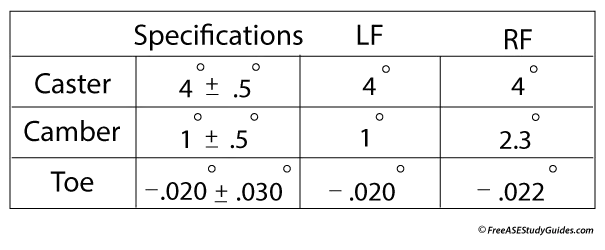A4 Steering and Suspension Quiz
1. A vehicle’s upper and lower ball joints are being inspected for wear. The coil spring is located between the frame and the lower control arm. Technician A says to place a jack under the lower control arm to unload the ball joint. Technician B says to place the jack under the frame to unload the ball joint. Who is correct?
2. Two technicians are discussing the toe setting of a front wheel drive vehicle with four wheel independent suspension. The right rear wheel is 1.5 degrees toe-in from specifications. Technician A says to set the front toe on this vehicle before correcting the rear. Technician B says the right rear wheels toe setting is 1.5 degrees positive (+). Who is correct?
3. Which of the following is a non-adjustable alignment angle that should be checked after setting the front toe?
4. Technician A says a vehicle with torsion bar suspension can be adjusted to repair ride height. Technician B says on some vehicles, torsion bars are used in place of coil springs. Who is correct?
5. A vehicle feels bouncy and is oscillating at highway speeds. The vehicle's shock absorbers may be faulty. Technician A says it is acceptable for a slight film to appear on the shock absorber's shaft. Technician B says a small drip of oil appearing from the shock absorber's chamber is acceptable. Who is correct?
6. A vehicle with a power rack and pinion steering system is binding during turns. Which of the following is LEAST likely to cause this condition.
7. Two technicians are discussing excessive wear on the inside tread of a tire. Technician A says an out of specification caster angle will cause this type of wear. Technician B says an out of specification camber angle will cause this type of wear. Who is correct?
8. After installing a power steering gear, the vehicle's air bag light is illuminated. Technician A says the vehicle's wheel alignment needs to be adjusted to repair this light. Technician B says the clockspring has been damaged. Who is correct?
9. The left front wheel is sitting back 1 1/8 inches further than the other. Technician A says this is an acceptable setback and designed into the vehicle to compensate for crowned roads. Technician B says front wheel setback will cause a vehicle to drift towards the side with the least wheel setback. Who is correct?

12. A front wheel drive vehicle is pulling to the left. Loose engine cradle bolts are noticed during the initial inspection. Technician A says loose engine cradle bolts will cause a vibration, but have no affect on the vehicle's steering system. Technician B says if the engine cradle is not centered before fastening the bolts, the wheel alignment angles will be affected. Who is correct?
13. Two technicians are discussing an electronic air suspension system. Technician A says the suspension switch must be turned off before lifting the vehicle. Technician B says to use soapy water to visually inspect this system for leaks. Who is correct?
14. Loose tie rods are discovered during the initial inspection of a vehicle's steering linkage. Technician A says loose tie rods will cause a clunking or popping noise while turning. Technician B says loose tie rods will result in constant steering correction and vehicle wander. Who is correct?
15. Technician A says a directional tire must be kept on the same side of the vehicle during a tire rotation. Technician B says tire inflation pressure is considered cold as long as the vehicle has been driven less than ten miles. Who is correct?
16. A vehicle has a steady pull to the left. All of these will cause this condition EXCEPT:
17. Technician A says a vehicle will pull to the side with the most positive camber. Technician B says that too much negative camber will result in excessive wear on the inside tread of the tire. Who is correct?
18. Two technicians are discussing inner and outer tie rods. Technician A says to turn the outer tie rod end to adjust the toe. Technician B says loose inner tie rod ends will cause a tire to feather. Who is correct?
19. The rear tires on a vehicle with independent rear suspension are worn on the inside tread. Which of the following is MOST likely the cause of this condition?
20. Technician A says SAI or Steering Angle Inclination is adjusted by changing the caster angle. Technician B says camber adjustments are included in the Included Angle. Who is correct?
Please select an answer
